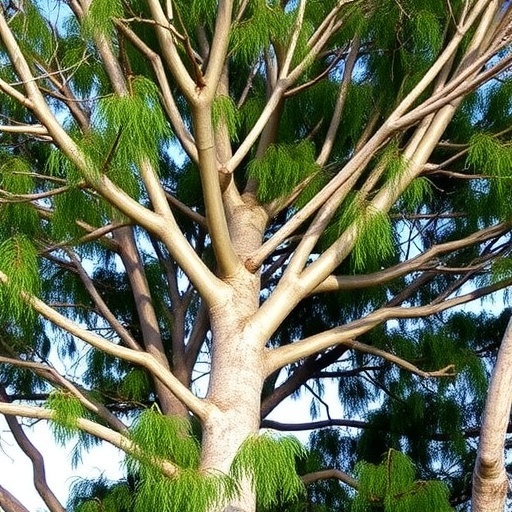In a groundbreaking study published in BMC Genomics, researchers have delved into the genetic underpinnings of heterosis in eucalypt growth, a phenomenon widely admired and utilized in agricultural biotechnology for its potential to boost crop yields. This research, spearheaded by Su and colleagues, leverages advanced transcriptome analysis to unlock the complexities of genetic interactions that contribute to the impressive growth rates observed in hybrid eucalypt varieties. Understanding heterosis, often described as hybrid vigor, has vast implications for improving not only the productivity of eucalypt plantations but also for the broader field of plant genetics.
Heterosis is often characterized by the enhanced biological performance of hybrid offspring compared to their parent strains. In eucalypts, which are fast-growing and economically significant trees, heterosis has been extensively exploited in forestry practices. This study distinguishes itself by focusing on the molecular mechanisms that underpin this phenomenon, thus offering insights into the intricate genetic webs that govern growth and development at a cellular level. Using high-throughput sequencing technology, the researchers analyzed the transcriptomic responses of various eucalypt hybrids, shedding light on the genes that contribute to their enhanced vigor.
The significance of this research cannot be overstated, especially considering the growing global demand for fast-growing tree species due to climate change and the need for renewable resources. Eucalypts, known for their efficient growth rates and adaptability to diverse environments, have become a focal point in efforts to develop sustainable forestry practices. By harnessing the power of heterosis, researchers believe they can optimize the genetic makeup of eucalypt species, leading to increased biomass production and an expanded capacity for carbon sequestration, thus contributing positively to climate change mitigation strategies.
In the study, the authors conducted a thorough comparative transcriptome analysis among hybrids and their parents, identifying differential gene expression patterns that correlate with hybrid vigor. The research revealed that a significant number of genes associated with growth, stress responses, and metabolic processes were upregulated in the hybrids. This lends credence to the hypothesis that genetic interactions, whether additive, dominant, or epistatic, play crucial roles in defining the hybrid’s overall performance.
Moreover, the study emphasizes the importance of epigenetic factors in the expression of heterosis. By analyzing DNA methylation patterns alongside transcriptomic data, the researchers were able to demonstrate that epigenetic modifications contribute to the plasticity of the hybrid’s growth responses. This dual approach highlights the complexity of genetic regulation and the interplay between genetic inheritance and environmental influences, offering a more holistic understanding of plant performance.
The implications of these findings extend beyond eucalypt species alone. The insights gained from this research can be applied more broadly, providing tools for plant breeders and geneticists aiming to enhance the productivity of other crops. By uncovering the genetic basis of heterosis, scientists can develop strategies for selecting favorable traits that contribute to hybrid vigor in a wide range of agricultural species. This has the potential to revolutionize breeding programs, offering a path toward sustainable increases in food production.
As the world grapples with the challenges posed by a rapidly changing climate, the relevance of such research becomes increasingly pivotal. The study encourages further exploration into the genetic mechanisms of heterosis, advocating for the integration of transcriptomic and epigenetic analysis in plant breeding efforts to maximize the potential of hybrid crops. Indeed, the implications for resource management, ecological balance, and economic viability are profound.
Given the complexity of heterosis, questions remain regarding the specific genes and pathways that trigger this phenomenon. The researchers call for additional studies that combine genomic, transcriptomic, and phenomic data to build a comprehensive picture of how these factors interact over time. Such integrative approaches could lead to innovative strategies for enhancing hybrid performance, thereby meeting the future demands for sustainable forestry and agricultural productivity.
Collaboration among geneticists, agronomists, and environmental scientists is crucial in pushing this frontier of research forward. As they build on the foundational work presented in this study, the scientific community is urged to share findings and methodologies that enhance our understanding of how to best leverage heterosis for environmental and economic gains. This cooperation will be key to developing resilient and high-performing crop varieties tailored to diverse ecological conditions.
In summary, Su et al.’s study on the genetic basis of heterosis in eucalypt growth presents far-reaching implications that touch on sustainability, climate resilience, and food security. The insights gained from transcriptome analysis not only illuminate the underlying genetic mechanisms of hybrid vigor but also set the stage for future advancements in plant genetics and breeding methodologies. As research progresses, the potential for harnessing nature’s genetic diversity to address global challenges becomes ever more achievable.
In conclusion, the exploration of hybrid vigor in eucalypt trees is much more than an academic pursuit; it represents a critical avenue for developing solutions to pressing environmental concerns. As the research community continues to uncover the genetic makeup of hybrid eucalypts, we stand on the precipice of making lasting impacts on forestry management and agricultural practices worldwide. The ramifications could redefine how we approach plant breeding and sustainability in the face of climate variability.
Subject of Research: Genetic basis of heterosis in eucalypt growth
Article Title: Exploring the genetic basis of heterosis in eucalypt growth based on transcriptome analysis
Article References:
Su, Z., Lu, W., Lin, Y. et al. Exploring the genetic basis of heterosis in eucalypt growth based on transcriptome analysis.
BMC Genomics 26, 880 (2025). https://doi.org/10.1186/s12864-025-12077-9
Image Credits: AI Generated
DOI: 10.1186/s12864-025-12077-9
Keywords: heterosis, eucalypt growth, genetic basis, transcriptome analysis, hybrid vigor, sustainable forestry, climate change, plant genetics.




